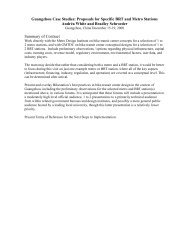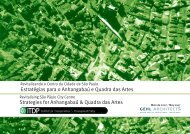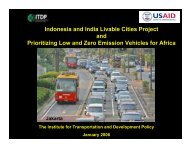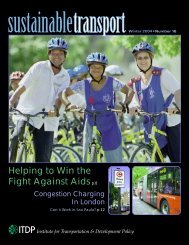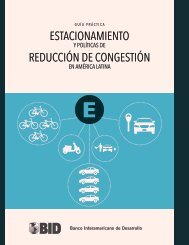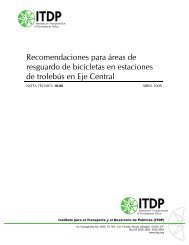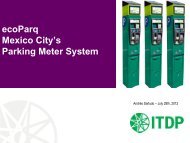BRT Standard - ITDP | Institute for Transportation and Development ...
BRT Standard - ITDP | Institute for Transportation and Development ...
BRT Standard - ITDP | Institute for Transportation and Development ...
Create successful ePaper yourself
Turn your PDF publications into a flip-book with our unique Google optimized e-Paper software.
The <strong>BRT</strong> <strong>St<strong>and</strong>ard</strong> Version 1.0 43<br />
Low Commercial Speeds:<br />
minimum average commercial<br />
speed below 13 kph (8 mph)<br />
-10 points<br />
Peak Passengers per Hour per<br />
Direction (pphpd) Below 1,000<br />
-5 points<br />
Most of the design features included in the<br />
scoring system will always result in higher<br />
speeds. However, there is an exception: higher<br />
dem<strong>and</strong> systems in which too many buses<br />
carrying too many passengers have been<br />
concentrated into a single lane. In this case,<br />
bus speeds could be lower than in mixed traffic<br />
conditions. To mitigate the risk of rewarding such<br />
a system with a quality st<strong>and</strong>ard, this penalty<br />
was imposed. Typical <strong>BRT</strong> operating speeds <strong>for</strong><br />
the better systems in central city areas tend to<br />
be about 15 kph (9.3 mph), so speeds below<br />
this indicate the system has been badly “fit” to<br />
the dem<strong>and</strong>. A penalty rather than a minimum<br />
qualification criterion <strong>for</strong> a slow speed <strong>BRT</strong> (as<br />
was previously used) allows such a system to still<br />
be considered <strong>BRT</strong>, but to achieve a lower score.<br />
Scoring Guidelines: The minimum average<br />
commercial speed refers to the system-wide<br />
average speed <strong>and</strong> not the average speed at the<br />
slowest link. A speed of 13 kph can generally<br />
be achieved in mixed-traffic conditions in a<br />
downtown area. If lower, all ten points should<br />
be deducted.<br />
Where commercial speed is not readily<br />
available, the full penalty should be imposed<br />
if buses are backing up at many <strong>BRT</strong> stations<br />
or junctions.<br />
low commercial speeds<br />
points<br />
<strong>BRT</strong> systems with ridership levels below 1,000<br />
passengers per peak hour per direction (pphpd)<br />
are carrying fewer passengers than a normal<br />
mixed-traffic lane. Very low ridership can be an<br />
indication that other bus services continue to<br />
operate in the corridor along side, <strong>and</strong> competing<br />
with, the <strong>BRT</strong> system. Alternatively, it indicates<br />
that a corridor was poorly selected.<br />
Almost all cities have corridors carrying at<br />
least 1,000 pphpd. Many cities, however, have<br />
corridors where transit dem<strong>and</strong> is very low, even<br />
below this level. While many Gold-<strong>St<strong>and</strong>ard</strong><br />
<strong>BRT</strong> features would still bring benefits in these<br />
conditions, it is unlikely that such levels would<br />
justify the cost <strong>and</strong> dedicated right-of-way<br />
intrinsic to <strong>BRT</strong>. This penalty has been created to<br />
penalize systems which have done a poor job of<br />
service planning or corridor selection, while not<br />
overly penalizing smaller, car-oriented cities with<br />
low transit dem<strong>and</strong>.<br />
Scoring Guidelines: All five points should be<br />
deducted if the ridership on the link in the corridor<br />
with maximum peak-hour ridership is under 1,000<br />
pphpd in the peak hour. Otherwise, no deduction<br />
is necessary.<br />
peak passengers per hour<br />
per direction (pphpd)<br />
points<br />
PPHPD below 1,000 -5<br />
Minimum average commercial speed -10<br />
is below 13 kph (8 mph)





